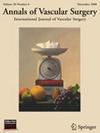GLP-1受体激动剂与糖尿病患者腹股沟下搭桥术后生存率提高相关。
IF 1.6
4区 医学
Q3 PERIPHERAL VASCULAR DISEASE
引用次数: 0
摘要
目的:美国糖尿病协会推荐胰高血糖素样肽-1受体激动剂(GLP1-RAs)(如Ozempic)用于动脉粥样硬化性心血管疾病(包括PAD)患者。我们假设增加GLP1-RAs的使用与旁路术后预后的改善有关。方法:回顾性分析2017-2024年在某多院医院行腹股沟下旁路手术的糖尿病患者,包括患者特征、手术细节和结局。主要结局是生存。次要结局包括围手术期并发症、主要肢体不良事件(MALE)、主要心血管不良事件(MACE)和代谢变化。Kaplan-Meier和Cox回归评估结果。结果:共有322例患者(男性62.5%,白人78.8%,中位年龄68岁[61-76])行了339次旁路手术。在研究期间,GLP1-RA的使用率从8.2%增加到18.8% (P=0.001)。GLP1-RA组患者(n=38, 11.2%)较年轻(65.5[57.0-71.0]对69.9[62.0-77.0]岁,P = 0.003), BMI较高(29.6[26.9-33.3]对27.2 [23.3-31.1]kg/m2, P < 0.001)。中位随访18[6-39]个月。GLP1-RA组患者2年生存率提高(94.7% vs. 71.8%, P=0.004)。经校正分析,GLP1-RA的使用与死亡率降低相关(aHR = 0.09, 95% CI 0.01-0.66, P = 0.02)。GLP-1 RA患者在2年时MACE的自由度更高(100% vs. 88.6%, P = 0.046)。两组之间的游离性相似。结论:GLP1-RA的使用在下肢搭桥患者中越来越普遍,并且与显著改善的术后生存和无MACE相关。需要进一步的研究来确认结果差异的原因。本文章由计算机程序翻译,如有差异,请以英文原文为准。
GLP-1 Receptor Agonists Associated With Improved Survival After Infrainguinal Bypass in Diabetic Patients
Background
The American Diabetes Association recommends the use of glucagon-like-peptide-1 receptor agonists (GLP1-RAs) (e.g., Ozempic) for patients with atherosclerotic cardiovascular disease, including peripheral artery disease. We hypothesized increasing the use of GLP1-RAs would be associated with improved outcomes after bypass.
Methods
Retrospective review of diabetic patients undergoing infrainguinal bypass at a multihospital institution between 2017 and 2024 was conducted, including patient characteristics, operative details, and outcomes. The primary outcome was survival. Secondary outcomes included perioperative complications, major adverse limb events, major adverse cardiovascular events (MACE), and metabolic changes. Kaplan–Meier and Cox regression evaluated outcomes.
Results
A total of 322 patients (62.5% male, 78.8% White, median age 68 [61–76] years) underwent 339 bypasses. GLP1-RA use increased from 8.2% to 18.8% during the study period (P = 0.001). Patients on a GLP1-RA (n = 38, 11.2%) were younger (65.5 [57.0–71.0] vs. 69.9 [62.0–77.0] years, P = 0.003) and had a higher body mass index (29.6 [26.9–33.3] vs. 27.2 [23.3–31.1] kg/m2, P < 0.001). Median follow-up was 18 [6–39] months. Improved survival at 2 years was seen among patients on a GLP1-RA (94.7% vs. 71.8%, P = 0.004). On adjusted analysis, GLP1-RA use was associated with reduced mortality (adjusted hazard ratio = 0.09, 95% confidence interval 0.01–0.66, P = 0.02). Freedom from MACE at 2 years was greater among patients on a GLP-1-RA (100% vs. 88.6%, P = 0.046). Freedom from major adverse limb events was similar between groups.
Conclusion
GLP1-RA use is increasingly common in patients undergoing lower extremity bypass and was associated with significantly improved postoperative survival and freedom from MACE. Further studies are required to confirm reasons for differences in outcomes.
求助全文
通过发布文献求助,成功后即可免费获取论文全文。
去求助
来源期刊
CiteScore
3.00
自引率
13.30%
发文量
603
审稿时长
50 days
期刊介绍:
Annals of Vascular Surgery, published eight times a year, invites original manuscripts reporting clinical and experimental work in vascular surgery for peer review. Articles may be submitted for the following sections of the journal:
Clinical Research (reports of clinical series, new drug or medical device trials)
Basic Science Research (new investigations, experimental work)
Case Reports (reports on a limited series of patients)
General Reviews (scholarly review of the existing literature on a relevant topic)
Developments in Endovascular and Endoscopic Surgery
Selected Techniques (technical maneuvers)
Historical Notes (interesting vignettes from the early days of vascular surgery)
Editorials/Correspondence

 求助内容:
求助内容: 应助结果提醒方式:
应助结果提醒方式:


